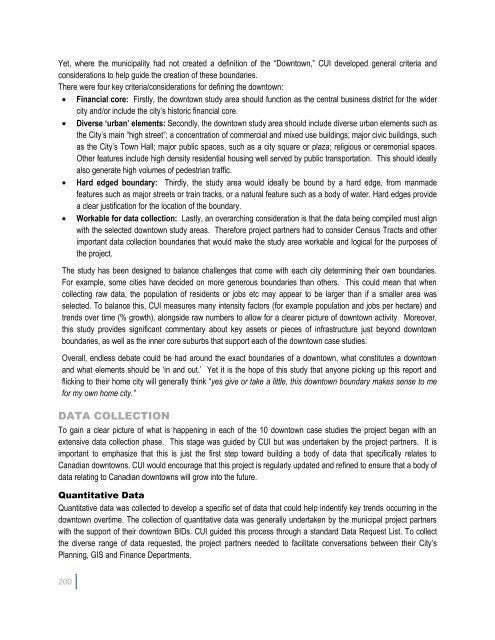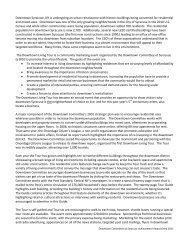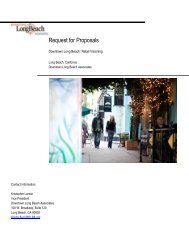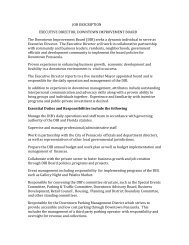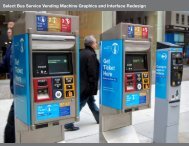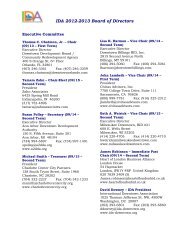The Value of Investing in Canadian Downtowns - International ...
The Value of Investing in Canadian Downtowns - International ...
The Value of Investing in Canadian Downtowns - International ...
You also want an ePaper? Increase the reach of your titles
YUMPU automatically turns print PDFs into web optimized ePapers that Google loves.
Yet, where the municipality had not created a def<strong>in</strong>ition <strong>of</strong> the “Downtown,” CUI developed general criteria and<br />
considerations to help guide the creation <strong>of</strong> these boundaries.<br />
<strong>The</strong>re were four key criteria/considerations for def<strong>in</strong><strong>in</strong>g the downtown:<br />
F<strong>in</strong>ancial core: Firstly, the downtown study area should function as the central bus<strong>in</strong>ess district for the wider<br />
city and/or <strong>in</strong>clude the city’s historic f<strong>in</strong>ancial core.<br />
Diverse ‘urban’ elements: Secondly, the downtown study area should <strong>in</strong>clude diverse urban elements such as<br />
the City’s ma<strong>in</strong> “high street”; a concentration <strong>of</strong> commercial and mixed use build<strong>in</strong>gs; major civic build<strong>in</strong>gs, such<br />
as the City’s Town Hall; major public spaces, such as a city square or plaza; religious or ceremonial spaces.<br />
Other features <strong>in</strong>clude high density residential hous<strong>in</strong>g well served by public transportation. This should ideally<br />
also generate high volumes <strong>of</strong> pedestrian traffic.<br />
Hard edged boundary: Thirdly, the study area would ideally be bound by a hard edge, from manmade<br />
features such as major streets or tra<strong>in</strong> tracks, or a natural feature such as a body <strong>of</strong> water. Hard edges provide<br />
a clear justification for the location <strong>of</strong> the boundary.<br />
Workable for data collection: Lastly, an overarch<strong>in</strong>g consideration is that the data be<strong>in</strong>g compiled must align<br />
with the selected downtown study areas. <strong>The</strong>refore project partners had to consider Census Tracts and other<br />
important data collection boundaries that would make the study area workable and logical for the purposes <strong>of</strong><br />
the project.<br />
<strong>The</strong> study has been designed to balance challenges that come with each city determ<strong>in</strong><strong>in</strong>g their own boundaries.<br />
For example, some cities have decided on more generous boundaries than others. This could mean that when<br />
collect<strong>in</strong>g raw data, the population <strong>of</strong> residents or jobs etc may appear to be larger than if a smaller area was<br />
selected. To balance this, CUI measures many <strong>in</strong>tensity factors (for example population and jobs per hectare) and<br />
trends over time (% growth), alongside raw numbers to allow for a clearer picture <strong>of</strong> downtown activity. Moreover,<br />
this study provides significant commentary about key assets or pieces <strong>of</strong> <strong>in</strong>frastructure just beyond downtown<br />
boundaries, as well as the <strong>in</strong>ner core suburbs that support each <strong>of</strong> the downtown case studies.<br />
Overall, endless debate could be had around the exact boundaries <strong>of</strong> a downtown, what constitutes a downtown<br />
and what elements should be ‘<strong>in</strong> and out.’ Yet it is the hope <strong>of</strong> this study that anyone pick<strong>in</strong>g up this report and<br />
flick<strong>in</strong>g to their home city will generally th<strong>in</strong>k “yes give or take a little, this downtown boundary makes sense to me<br />
for my own home city.”<br />
DATA COLLECTION<br />
To ga<strong>in</strong> a clear picture <strong>of</strong> what is happen<strong>in</strong>g <strong>in</strong> each <strong>of</strong> the 10 downtown case studies the project began with an<br />
extensive data collection phase. This stage was guided by CUI but was undertaken by the project partners. It is<br />
important to emphasize that this is just the first step toward build<strong>in</strong>g a body <strong>of</strong> data that specifically relates to<br />
<strong>Canadian</strong> downtowns. CUI would encourage that this project is regularly updated and ref<strong>in</strong>ed to ensure that a body <strong>of</strong><br />
data relat<strong>in</strong>g to <strong>Canadian</strong> downtowns will grow <strong>in</strong>to the future.<br />
Quantitative Data<br />
Quantitative data was collected to develop a specific set <strong>of</strong> data that could help <strong>in</strong>dentify key trends occurr<strong>in</strong>g <strong>in</strong> the<br />
downtown overtime. <strong>The</strong> collection <strong>of</strong> quantitative data was generally undertaken by the municipal project partners<br />
with the support <strong>of</strong> their downtown BIDs. CUI guided this process through a standard Data Request List. To collect<br />
the diverse range <strong>of</strong> data requested, the project partners needed to facilitate conversations between their City’s<br />
Plann<strong>in</strong>g, GIS and F<strong>in</strong>ance Departments.<br />
200


